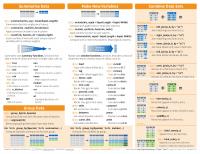DataCamp PythonForDataScience
276 88 212KB
English Pages [1] Year 2018
Recommend Papers

- Author / Uploaded
- it-ebooks
File loading please wait...
Citation preview
Python For Data Science Cheat Sheet Python Basics
Learn More Python for Data Science Interactively at www.datacamp.com
Lists >>> >>> >>> >>>
Also see NumPy Arrays a = 'is' b = 'nice' my_list = ['my', 'list', a, b] my_list2 = [[4,5,6,7], [3,4,5,6]]
Selecting List Elements
Variables and Data Types
Subset
Variable Assignment >>> x=5 >>> x 5
>>> my_list[1] >>> my_list[-3]
Select item at index 1 Select 3rd last item
>>> >>> >>> >>>
Select items at index 1 and 2 Select items after index 0 Select items before index 3 Copy my_list
Slice
Calculations With Variables
>>> x+2
Sum of two variables
>>> x-2
Subtraction of two variables
>>> x*2
Multiplication of two variables
>>> x**2
Exponentiation of a variable
>>> x%2
Remainder of a variable
>>> x/float(2)
Division of a variable
7
3
10 25 1
Index starts at 0
2.5
my_list[1:3] my_list[1:] my_list[:3] my_list[:]
Subset Lists of Lists
>>> my_list2[1][0] >>> my_list2[1][:2]
my_list[list][itemOfList]
str()
'5', '3.45', 'True'
Variables to strings
int()
5, 3, 1
Variables to integers
>>> my_list + my_list
['my', 'list', 'is', 'nice', 'my', 'list', 'is', 'nice']
>>> my_list * 2
['my', 'list', 'is', 'nice', 'my', 'list', 'is', 'nice']
>>> my_list2 > 4
float()
5.0, 1.0
Variables to floats
bool()
True, True, True
Variables to booleans
Asking For Help >>> help(str)
my_list.index(a) my_list.count(a) my_list.append('!') my_list.remove('!') del(my_list[0:1]) my_list.reverse() my_list.extend('!') my_list.pop(-1) my_list.insert(0,'!') my_list.sort()
'thisStringIsAwesome'
String Operations >>> my_string * 2
'thisStringIsAwesomethisStringIsAwesome'
>>> my_string + 'Innit' 'thisStringIsAwesomeInnit'
>>> 'm' in my_string True
Machine learning
Scientific computing
2D plotting
Free IDE that is included with Anaconda
Leading open data science platform powered by Python
Create and share documents with live code, visualizations, text, ...
Numpy Arrays
Also see Lists
Selecting Numpy Array Elements Subset
>>> my_array[1]
Get the index of an item Count an item Append an item at a time Remove an item Remove an item Reverse the list Append an item Remove an item Insert an item Sort the list
Index starts at 0
Select item at index 1
Slice
>>> my_array[0:2]
Select items at index 0 and 1
array([1, 2])
Subset 2D Numpy arrays
>>> my_2darray[:,0]
my_2darray[rows, columns]
array([1, 4])
Numpy Array Operations >>> my_array > 3
array([False, False, False,
>>> my_array * 2
True], dtype=bool)
array([2, 4, 6, 8])
>>> my_array + np.array([5, 6, 7, 8]) array([6, 8, 10, 12])
Strings >>> my_string = 'thisStringIsAwesome' >>> my_string
Data analysis
Install Python
2
List Methods >>> >>> >>> >>> >>> >>> >>> >>> >>> >>>
Import libraries >>> import numpy >>> import numpy as np Selective import >>> from math import pi
>>> my_list = [1, 2, 3, 4] >>> my_array = np.array(my_list) >>> my_2darray = np.array([[1,2,3],[4,5,6]])
List Operations
True
Types and Type Conversion
Libraries
String Operations
Index starts at 0
>>> my_string[3] >>> my_string[4:9]
String Methods >>> >>> >>> >>> >>>
String to uppercase my_string.upper() String to lowercase my_string.lower() Count String elements my_string.count('w') my_string.replace('e', 'i') Replace String elements my_string.strip() Strip whitespaces
Numpy Array Functions >>> >>> >>> >>> >>> >>> >>> >>>
my_array.shape np.append(other_array) np.insert(my_array, 1, 5) np.delete(my_array,[1]) np.mean(my_array) np.median(my_array) my_array.corrcoef() np.std(my_array)
DataCamp
Get the dimensions of the array Append items to an array Insert items in an array Delete items in an array Mean of the array Median of the array Correlation coefficient Standard deviation
Learn Python for Data Science Interactively









